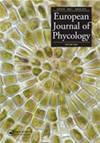First records of the non-indigenous green algal species Siphonocladus tropicus (Cladophorales, Chlorophyta) and Caulerpa integerrima (Bryopsidales, Chlorophyta) in the Mediterranean Sea
IF 1.7
4区 生物学
Q2 MARINE & FRESHWATER BIOLOGY
引用次数: 0
Abstract
ABSTRACT We provide an account of two newly recorded non-indigenous tropical seaweed species, Siphonocladus tropicus (Cladophorales, Chlorophyta) and Caulerpa integerrima (Caulerpaceae, Chlorophyta), from the northern and central Levantine Mediterranean shores of Israel. Reports are supported by morphological and molecular evidence. The new record of C. integerrima, thought to be endemic to the Red Sea, increases the number of non-indigenous Caulerpa species in the Mediterranean Sea to eight. Siphonocladus tropicus, a widespread tropical species, is also being reported from the northern Red Sea. Furthermore, morphological comparison of populations from the northern Red Sea and the Levantine Mediterranean shore of Israel revealed that there might be a regional variant or form of this species in the northern Red Sea and might indicate that this new invader does not necessarily originate from the Red Sea. The increasingly tropical conditions in the eastern Levantine Sea as a result of global warming probably paved the way for the establishment of both species in the region. Aspects of the new invaders’ ecology in the Israeli Levantine Sea, the possible vectors of introduction and origins, as well as the status of other Caulerpa species from both Levantine and Red Sea shores, are discussed. HIGHLIGHTS Siphonocladus tropicus and Caulerpa integerrima are new non-native species found lately in the Mediterranean Sea. Caulerpa integerrima originated from the Red Sea whereas the origin of Siphonocladus tropicus is uncertain. The introduction of these two alien species, especially Caulerpa integerrima, might pose a threat to the local marine flora and fauna.地中海非本土绿藻物种热带细枝藻(枝藻目,绿藻门)和肠藻(苔藓纲,绿藻目)的首次记录
摘要:我们提供了两种新记录的非本土热带海藻物种,即来自以色列黎凡特地中海北部和中部海岸的热带细枝藻(枝藻目,绿藻目)和小茎藻(小茎藻科,绿藻纲)。这些报告得到了形态学和分子证据的支持。被认为是红海特有的C.integerrima的新记录使地中海的非本土Caulpa物种数量增加到8种。热带细叶蜂是一种广泛分布的热带物种,也有报道称其分布于红海北部。此外,对红海北部和以色列黎凡特地中海沿岸种群的形态比较表明,在红海北部可能存在该物种的区域变体或形式,并可能表明这种新入侵者不一定起源于红海。由于全球变暖,黎凡特海东部日益热带化的条件可能为这两个物种在该地区的建立铺平了道路。讨论了以色列黎凡特海新入侵者的生态、可能的引入媒介和起源,以及黎凡特和红海海岸其他Caulpa物种的状况。亮点热带Siphonocladus tropicus和Caulpa intelgrima是最近在地中海发现的新的非本地物种。柄壶菌起源于红海,而热带细柄壶菌的起源尚不确定。引入这两种外来物种,尤其是肠叶藻,可能会对当地的海洋动植物构成威胁。
本文章由计算机程序翻译,如有差异,请以英文原文为准。
求助全文
约1分钟内获得全文
求助全文
来源期刊

European Journal of Phycology
生物-海洋与淡水生物学
CiteScore
4.80
自引率
4.20%
发文量
37
审稿时长
>12 weeks
期刊介绍:
The European Journal of Phycology is an important focus for the activities of algal researchers all over the world. The Editors-in-Chief are assisted by an international team of Associate Editors who are experts in the following fields: macroalgal ecology, microalgal ecology, physiology and biochemistry, cell biology, molecular biology, macroalgal and microalgal systematics, applied phycology and biotechnology. The European Journal of Phycology publishes papers on all aspects of algae, including cyanobacteria. Articles may be in the form of primary research papers and reviews of topical subjects.
The journal publishes high quality research and is well cited, with a consistently good Impact Factor.
 求助内容:
求助内容: 应助结果提醒方式:
应助结果提醒方式:


